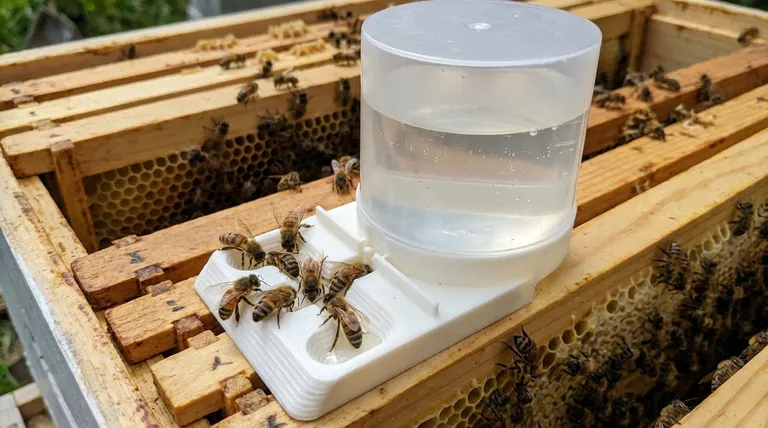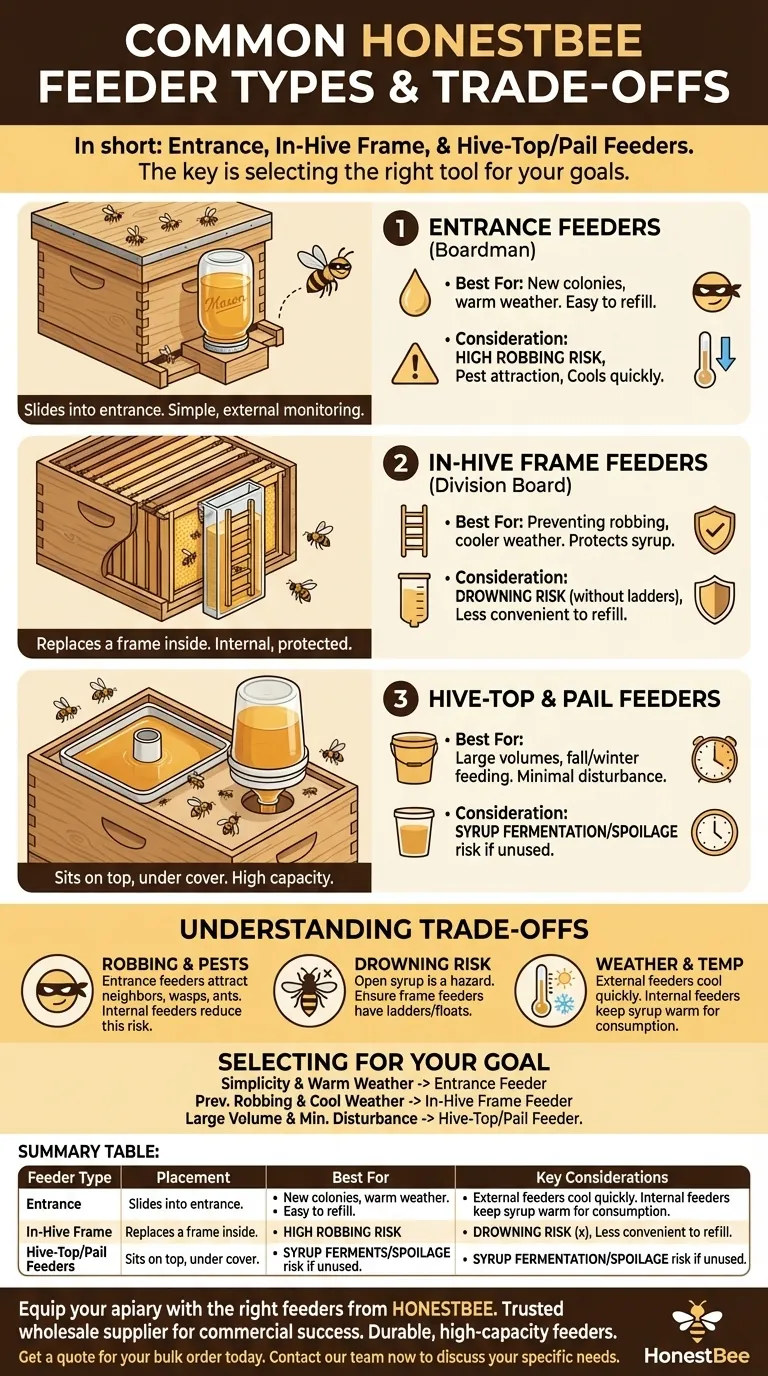In short, the most common types of honey bee feeders are entrance feeders, in-hive frame feeders, and hive-top feeders. Each design serves a distinct purpose, offering a different balance of capacity, convenience, and protection for the bees depending on the season and the beekeeper's goals.
The central challenge isn't finding a feeder, but selecting the right tool for the specific job. The ideal choice depends entirely on your goals, whether you are stimulating spring growth, feeding a new colony, or providing critical winter stores.

A Closer Look at Common Feeder Types
Choosing a feeder requires understanding how each design interacts with the hive and the external environment. They are generally categorized by where they are placed: at the entrance, inside the hive, or on top of it.
Entrance Feeders (Boardman Feeders)
An entrance feeder is one of the most basic and recognizable types. It consists of a small base that slides into the hive entrance, holding an inverted jar (often a standard Mason jar) filled with syrup.
Bees access the syrup through small holes in the jar's lid. Because the feeder is external, it's exceptionally easy to monitor the syrup level and refill the jar without disturbing the colony.
In-Hive Frame Feeders (Division Board Feeders)
These feeders are designed to take the place of one or two frames inside a brood box or super. They are essentially thin, plastic tanks that sit flush with the other frames.
This internal placement protects the syrup from cold weather and, most importantly, from robbing by bees from other colonies. Most modern frame feeders include internal ladders or floats to prevent bees from drowning.
Hive-Top Feeders
As the name implies, these high-capacity feeders sit directly on top of the uppermost hive box, beneath the outer cover. Bees access the syrup from below, often through a central chimney or protected channel.
Their significant volume makes them ideal for feeding large amounts of syrup quickly, such as when preparing a colony for winter. This placement also minimizes disturbance, as you can refill them without directly exposing the brood nest.
Pail Feeders (Gravity Feeders)
A pail feeder is a simple and effective high-capacity option. It is typically a bucket with a screened hole in the lid, which is inverted over the hole in the hive's inner cover.
Gravity and vacuum pressure keep the syrup from flowing out too quickly. Like hive-top feeders, they allow you to deliver a large volume of food with minimal intrusion into the hive.
Understanding the Trade-offs
No feeder is perfect for all situations. Your decision involves balancing convenience against the well-being and security of your colony.
Robbing and Pest Attraction
Entrance feeders are highly susceptible to robbing. Their external placement and proximity to the entrance can attract bees from neighboring hives, as well as wasps and ants. This can lead to intense fighting and can overwhelm a weak colony. Internal feeders (frame and top feeders) largely eliminate this risk.
Drowning Risk
Any open container of syrup poses a drowning risk. While entrance feeders are generally safe, frame feeders without built-in floats or ladders can be a significant hazard. Hive-top feeders are designed with specific channels to provide safe access, but it's crucial to ensure they are assembled and placed correctly.
Weather and Temperature Exposure
Syrup in an external entrance feeder will quickly cool to the ambient air temperature. Bees may be unable or unwilling to consume syrup that is too cold. In-hive feeders keep the syrup closer to the warmth of the cluster, making it more accessible during cooler weather.
Capacity and Convenience
Entrance feeders are convenient for quick checks but have a low capacity, requiring frequent refilling. Hive-top and pail feeders have a very large capacity, reducing your workload, but can lead to syrup fermenting or spoiling if the colony cannot consume it fast enough.
Selecting the Right Feeder for Your Goal
Your choice should be dictated by the season and what you are trying to accomplish for your bees.
- If your primary focus is simplicity for a new, small colony in warm weather: An entrance feeder is an excellent, low-cost choice for easy monitoring.
- If your primary focus is preventing robbing and feeding in cooler weather: An in-hive frame feeder protects the syrup and keeps it warm.
- If your primary focus is delivering large volumes of food with minimal disturbance: A hive-top or pail feeder is the most efficient option for fall feeding or supporting a large, established colony.
Ultimately, understanding these designs and their inherent trade-offs empowers you to provide the right support for your bees exactly when they need it most.
Summary Table:
| Feeder Type | Placement | Best For | Key Considerations |
|---|---|---|---|
| Entrance Feeder | Hive Entrance | New colonies, warm weather | Easy to refill, but high robbing risk |
| In-Hive Frame Feeder | Inside Brood Box | Preventing robbing, cooler weather | Protects syrup, but check for drowning risk |
| Hive-Top / Pail Feeder | Top of Hive | Large volumes, fall/winter feeding | High capacity, minimal disturbance |
Equip your apiary with the right feeders from HONESTBEE.
As a trusted wholesale supplier for commercial apiaries and equipment distributors, we provide durable, high-capacity feeders designed for professional beekeeping success. Our selection helps you manage feeding efficiently, reduce robbing, and support colony health year-round.
Get a quote for your bulk order today and see the HONESTBEE difference. Contact our team now to discuss your specific needs.
Visual Guide

Related Products
- HONESTBEE Entrance Bee Feeder Professional Hive Nutrition Solution for Beekeeping
- HONESTBEE Professional Hive Top Bee Feeder Feeding Solution
- Classic Boardman Entrance Bee Feeder Hive Front Feeding Solution
- Professional In-Hive Frame Bee Feeder by HONESTBEE
- HONESTBEE Professional Entrance Bee Feeder Hive Nutrition Solution
People Also Ask
- How to make an entrance feeder for bees? A DIY Guide for Safe & Effective Feeding
- What are the different types of honey bee feeders? Choose the Right Feeder for Your Hive
- What is the best feeder for bees? Choose the Right Feeder for Your Hive's Success
- Are entrance feeders good for bees? Prioritize Hive Health Over Convenience
- What is an entrance feeder? A Guide to Its Simple Design and High Robbing Risk



















